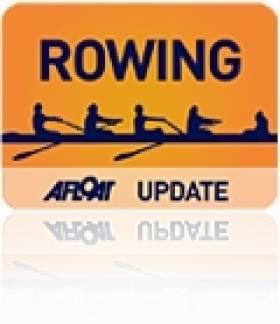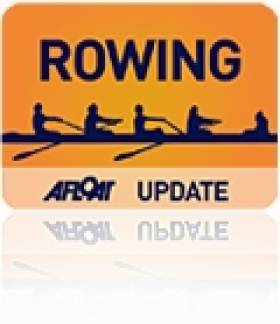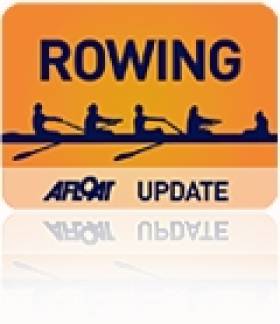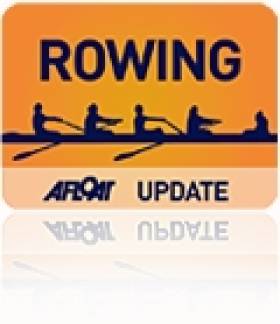Displaying items by tag: World Rowing Championships
#ROWING: Ireland’s pair of Leonora Kennedy and Lisa Dilleen took fifth in their semi-final at the World Rowing Championships in Amsterdam this morning. The strong United States and New Zealand crews took the first two A Final spots, while Ireland fought it out with Australia’s Charlotte Sutherland and Lucy Stephan for the third, with Serbia also in touch. The Australians eked out a lead of almost three seconds by 1500 metres and got away from the Irish in the final quarter. Serbia edged Ireland into fifth when the third place was gone.
World Rowing Championships, Day Five (Irish interest; selected results)
Women
Pair – Semi-Finals (First Three to A Final; rest to B Final) 1 United States (M Kalmoe, K Simmonds) 7:16.35, 2 New Zealand (L Trappitt, R Scown) 7:22.12, 3 Australia (C Sutherland, L Stephan) 7:30.02; 4 Serbia 7:34.92, 5 Ireland (L Kennedy, L Dilleen) 7:35.18, 6 Czech Republic 7:45.68.
#ROWING: Sanita Puspure took her place in the semi-finals of the women’s single sculls at the World Rowing Championships in Amsterdam today. The 32-year-old led for most of the race but was passed by Russian veteran Julia Levina (41) in the final quarter.
The Ireland women’s four found the going tough again in their repechage and will compete in the B Final of this 10-boat event. Canada and the Ukraine took the two places available in the A Final, while Ireland finished sixth.
World Rowing Championships, Day Four (Selected Results; Irish interest)
Men
Lightweight Single Sculls – Quarter-Final (First Three to A/B Semi-Finals; rest to C/D Semi-Finals): 1 Germany (L Hartig) 7:13.67, 2 Ireland (P O’Donovan) 7:14.76, 3 Denmark (S Jensen) 7:33.91; 4 Azerbaijan 7:25.84, 5 Russia 7:33.91, 6 Algeria 7:43.76.
Women
Four – Repechage (First Two to A Final; rest to B Final): 1 Canada 7:03.51, Ukraine 7:05.31; 3 Netherlands 7:06.85, 4 Germany 7:10.32, 5 Italy 7:17.82, 6 Ireland (M O’Neill, E Tormey, A Keogh, B O’Brien) 7:22.82.
Double Sculls – Repechage Three (First Two to A/B Semi-Final: rest to C/D Semi-Final): 1 United States (M O’Leary, E Tomek) 7:18.10, 2 Ireland (H Hannigan, M Dukarska) 7:21.14; 3 Romania 7:22.87, 4 Estonia 7:48.85.
Single Sculls – Quarter-Final Three (First Three to A/B Semi-Final; rest to C/D Semi-Finals): 1 Russia (J Levina) 8:00.54, 2 Ireland (S Puspure) 8:02.31, 3 Lithuania (L Saltyte) 8:08.41; 4 Belarus 8:24.58, 5 Norway 8:25.56, 6 Hungary 8:29.50.
#ROWING: Ireland’s new women’s double of Helen Hanningan (neé Walshe) and Monika Dukarska made a significant breakthrough at the World Rowing Championships in Amsterdam today, qualifying for the A/B Semi-Finals. The target was a place in the top two of their repechage. Romania made the early pace, with Ireland and the United States joining them in the challenge. By the closing stagest the US had their place sewn up, while Dukarska and Hannigan took out Romania to enter the top 12 crews at the Championships.
World Rowing Championships, Day Four (Selected Results; Irish interest)
Men
Lightweight Single Sculls – Quarter-Final (First Three to A/B Semi-Finals; rest to C/D Semi-Finals): 1 Germany (L Hartig) 7:13.67, 2 Ireland (P O’Donovan) 7:14.76, 3 Denmark (S Jensen) 7:33.91; 4 Azerbaijan 7:25.84, 5 Russia 7:33.91, 6 Algeria 7:43.76.
Women
Double Sculls – Repechage Three (First Two to A/B Semi-Final: rest to C/D Semi-Final): 1 United States (M O’Leary, E Tomek) 7:18.10, 2 Ireland (H Hannigan, M Dukarska) 7:21.14; 3 Romania 7:22.87, 4 Estonia 7:48.85.
O'Donovan's Second-Half Speed Secures World Rowing Semi-Final Place
#ROWING: Paul O’Donovan put in a brilliant second 1,000 metres to secure a semi-final place in the lightweight single sculls at the World Rowing Championships in Amsterdam today. O’Donovan needed to finish in the top three of the quarter-final to progress, but he was was fifth at half way, over one-and-a-half seconds behind third-placed Steffen Jensen of Denmark, with Russia’s Alexandr Tufanyuk fighting it out with Lars Hartig of Germany at the head of the field. O’Donovan turned it on in the second half. As the Russian faded, the Irishman took over in third behind Hartig and Jensen, and then passed the Dane to take second – just over a second behind Hartig.
In a major shock, the World Under-23 champion, Andrew Campbell Jr of the United States, made his exit when he fell out of the boat in the immediately preceding heat.
World Rowing Championships, Day Four (Selected Results; Irish interest)
Men
Lightweight Single Sculls – Quarter-Final (First Three to A/B Semi-Finals; rest to C/D Semi-Finals): 1 Germany (L Hartig) 7:13.67, 2 Ireland (P O’Donovan) 7:14.76, 3 Denmark (S Jensen) 7:33.91; 4 Azerbaijan 7:25.84, 5 Russia 7:33.91, 6 Algeria 7:43.76.
Ireland Lightweight Double Pipped for World Rowing Semi-Final Spot
#ROWING: Sweden pushed Ireland out of the vital second spot in the repechage of the lightweight double sculls at the World Rowing Championships in Amsterdam today. The race developed into a three-boat battle to land the two spots in the A/B Semi-Finals: world champions Italy and Ireland, who had a very good third quarter, led early leaders Sweden at 1500 metres. The Swedes came back, however, and pipped Ireland by .51 of a second. Ireland's Claire Lambe and Denise Walsh are now set to compete in the C/D Semi-Finals.
World Rowing Championships, Amsterdam, Day Three (Selected Results; Irish interest)
Women
Lightweight Double Sculls – Repechage Four (First Two to A/B Semi-Finals; rest to C/D Semi-Finals): 1 Italy (L Milani, E Sancassani) 7:40.06, 2 Sweden (C Lilja, E Fredh) 7:43.11, 3 Ireland (C Lambe, D Walsh) 7:43.62, 4 Belarus 7:55.20.
Fourth for Hannigan and Dukarska in First World Rowing Test
#ROWING: The new Ireland women’s double scull of Monika Dukarska and Helen Hannigan (neé Walshe) took fourth in their heat at the World Rowing Championships in Amsterdam today. Lithuania and the Ukraine fought it out at the head of the field, with Lithuania pulling away at the end. Ireland were in third at 1500 metres but yielded this to Denmark at the finish.
The Ireland women’s four were off the pace in their heat and finished fifth. The New Zealand four were extremely impressive in their win, and France held off Canada to take the second qualification spot for the A Final.
World Rowing Championships, Amsterdam, Day Two (Selected Results, Irish interest)
Men
Lightweight Pair – Heat Two (First Two to A/B Semi-Finals; rest to Repechage): 1 Ireland (M O’Donovan, N Kenny) 6:53.54, 2 China (Zhenwei Hou, Fanbing Zhang) 6:54.57; 3 Switzerland 7:03.74, 4 Australia 7:10.31, 5 Bulgaria 7:13.05, 6 Austria 7:19.39.
Women
Four – Heat One (First Two to A Final; rest to Repechage): 1 New Zealand 6:46.42, 2 France 7:01.16; 3 Canada 7:03.68, 4 Italy 7:09.17, 5 Ireland (M O’Neill, E Tormey, A Keogh, B O’Brien) 7:19.28.
Double Sculls – Heat One (Winner to A/B Semi-Finals; rest to Repechage): 1 Lithuania (D Vistartaite, M Valciukaite) 7:05.28; 2 Ukraine 7:09.74, 3 Denmark 7:24.04, 4 Ireland (H Walshe, M Dukarska) 7:24.59, 5 Austria 7:29.06, 6 Bulgaria 7:49.72.
Superb Win For Kenny and O'Donovan over World Rowing Champions
#ROWING: The Ireland lightweight pair of Niall Kenny and Mark O’Donovan caused a major upset on the second day of the World Rowing Championships in Amsterdam today. The new crew at international level won their heat, beating World and European champions Switzerland. The Swiss set a blistering early pace and drew well clear, but the Irish had by far the better second 1,000 metres. They caught and passed the Swiss, who could not meet the challenge and actually stopped before getting going again, allowing China to take the second qualification spot.
World Rowing Championships, Amsterdam, Day Two (Selected Results, Irish interest)
Men
Lightweight Pair – Heat Two (First Two to A/B Semi-Finals; rest to Repechage): 1 Ireland (M O’Donovan, N Kenny) 6:53.54, 2 China (Zhenwei Hou, Fanbing Zhang) 6:54.57; 3 Switzerland 7:03.74, 4 Australia 7:10.31, 5 Bulgaria 7:13.05, 6 Austria 7:19.39.
Puspure Wins Heat at World Rowing Championships
#ROWING: Sanita Puspure won her heat of the women’s single sculls at the World Rowing Championships in Amsterdam today to guarantee a good lane draw in the quarter-finals. The Old Collegians sculler lay second behind China’s Jingli Duan at halfway but passed her in the third quarter and moved away to win well. The Netherlands, China and Croatia also qualified.
World Rowing Championships, Amsterdam (Selected Results; Irish interest)
Men
Lightweight Single Sculls – Heat Two (First Four Directly to Quarter-Finals; rest to Repechage): 1 Portugal (P Fraga) 6:53.62, Australia (P Ward) 6:54.96, 3 Ireland (P O’Donovan) 6:57.65,4 China (Jingbin Zhao) 7:03.13; 5 Slovakia 7:04.81, 6 Quatar 9:52.93.
Women
Pair – Heat Two (First Three Directly to A/B Semi-Finals; rest to Repechage): 1 Britain (H Glover, H Stanning) 7:04.64, 2 Ireland (L Kennedy, L Dilleen) 7:15.29, 3 Canada (J Martins, K Bauder) 7:04.64; 4 Serbia 7:21.06, 5 Russia 7:24.48.
Lightweight Double Sculls – Heat One (Winner to A/B Semi-Final; rest to Repechage): 1 Australia (A McNamara, E Flecker) 6:57.15; 2 Germany 7:00.24, 3 Ireland (C Lambe, D Walsh) 7:01.23, 4 Russia 7:02.71, 5 Denmark 7:07.89.
Single Sculls – Heat Four (First Four Directly to Quarter-Finals; rest to Repechage): 1 Ireland (S Puspure) 7:33.03, 2 Netherlands (L Scheenaard) 7:36.69, 3 China (Jingli Duan) 7:38.16, 4 Croatia (M Milosevic) 7:39.48; 5 Italy 8:19.49.
Battling Lambe and Walsh Set for World Rowing Repechage
#ROWING: Claire Lambe and Denise Walsh finished third in their heat of the lightweight double sculls at the World Rowing Championships in Amsterdam today. Just one crew qualified directly for the semi-finals and Lambe and Walsh were competitive and did not let early leaders Germany break away from them. However, Australia finished faster than both and won the race.
World Rowing Championships, Amsterdam (Selected Results; Irish interest)
Men
Lightweight Single Sculls – Heat Two (First Four Directly to Quarter-Finals; rest to Repechage): 1 Portugal (P Fraga) 6:53.62, Australia (P Ward) 6:54.96, 3 Ireland (P O’Donovan) 6:57.65,
4 China (Jingbin Zhao) 7:03.13; 5 Slovakia 7:04.81, 6 Quatar 9:52.93.
Women
Pair – Heat Two (First Three Directly to A/B Semi-Finals; rest to Repechage): 1 Britain (H Glover, H Stanning) 7:04.64, 2 Ireland (L Kennedy, L Dilleen) 7:15.29, 3 Canada (J Martins, K Bauder) 7:04.64; 4 Serbia 7:21.06, 5 Russia 7:24.48.
Lightweight Double Sculls – Heat One (Winner to A/B Semi-Final; rest to Repechage): 1 Australia (A McNamara, E Flecker) 6:57.15; 2 Germany 7:00.24, 3 Ireland (C Lambe, D Walsh) 7:01.23, 4 Russia 7:02.71, 5 Denmark 7:07.89.
Impressive Row by Dilleen and Kennedy at World Championships
#ROWING: Lisa Dilleen and Leonora Kennedy kept the good results coming for Ireland on the first day of the World Rowing Championships in Amsterdam. The women’s pair took an impressive second place in their heat behind the dominant crew, Olympic champions Helen Glover and Heather Stanning of the United Kingdom, thus qualifying directly for the semi-finals. Russia and Ireland battled it out for second in the middle stages, and as the Russians faded Canada launched an attack, but Dilleen and Kennedy won both battles. Canada took the third qualification spot.
World Rowing Championships, Amsterdam (Selected Results; Irish interest)
Men
Lightweight Single Sculls – Heat Two (First Four Directly to Quarter-Finals; rest to Repechage): 1 Portugal (P Fraga) 6:53.62, Australia (P Ward) 6:54.96, 3 Ireland (P O’Donovan) 6:57.65,
4 China (Jingbin Zhao) 7:03.13; 5 Slovakia 7:04.81, 6 Quatar 9:52.93.
Women
Pair – Heat Two (First Three Directly to A/B Semi-Finals; rest to Repechage): 1 Britain (H Glover, H Stanning) 7:04.64, 2 Ireland (L Kennedy, L Dilleen) 7:15.29, 3 Canada (J Martins, K Bauder) 7:04.64; 4 Serbia 7:21.06, 5 Russia 7:24.48.







































































